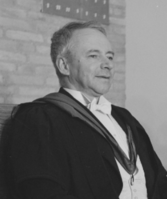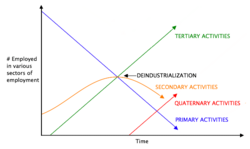Colin Clark (economist) facts for kids
Quick facts for kids
Colin Clark
|
|
|---|---|
 |
|
| Born | 2 November 1905 London, England
|
| Died | 4 September 1989 (aged 83) Brisbane, Australia
|
| Nationality | British/Australian |
| Alma mater | Oxford University |
| Scientific career | |
| Fields | Economics |
| Institutions | Oxford University, Cambridge University, Monash University, University of Queensland |
| Doctoral students | Sir Richard Stone V.K.R.V. Rao Sir Alexander Cairncross Hans Singer |
| Influenced | Angus Maddison |
Colin Grant Clark (2 November 1905 – 4 September 1989) was a British and Australian economist and statistician who worked in both the United Kingdom and Australia. He pioneered the use of gross national product (GNP) as the basis for studying national economies.
Contents
Early years
Colin Clark was born in London in 1905 and was educated at the Dragon School in Oxford, then at Winchester College. He subsequently attended Brasenose College, Oxford, where he graduated in Chemistry in 1928. After graduation he worked as a research assistant with William Beveridge at the London School of Economics (1928–29) and then with Sir Alexander Carr-Saunders and Allyn Young at the University of Liverpool (1929–30). During this time he ran unsuccessful campaigns to be elected to parliament for the Labour Party in the constituency of North Dorset (1929), and later at Liverpool Wavertree (1931) and South Norfolk (1935).
In 1930 he was appointed a research assistant to the National Economic Advisory Council newly convened by Prime Minister Ramsay MacDonald. He resigned shortly after his appointment, after being asked to write a background memorandum to make a case for protectionism. Despite this, he had sufficiently impressed one of the council members (John Maynard Keynes) to secure an appointment as a lecturer in statistics at Cambridge University.
Lecturer at Cambridge
At Cambridge, he was a lecturer in Statistics from 1931 to 1938. There he also completed three books: The National Income 1924–31 (1932), The Economic Position of Great Britain (jointly with A. C. Pigou) (1936) and National Income and Outlay (1937). His first book was sent to the publisher Daniel Macmillan with a recommendation from John Maynard Keynes: "[...] Clark is, I think, a bit of a genius: almost the only economic statistician I have ever met who seems to me quite first-class."
Move to Australia

During a visit to Australia and New Zealand in 1937 and 1938 he accepted a position with the Queensland Government at the invitation of the premier Forgan Smith. At the time he wrote to Keynes about his decision to stay in Australia. As he put it, the chance to advise the Queensland Premier on 'practically everything connected with economic matters' was 'too remarkable an opportunity to be missed for putting economics into practice'
On 6 May 1938, he was appointed Government Statistician, Director of the Bureau of Industry, and Financial Advisor to the Queensland Treasury, and provided the State's first set of economic accounts in 1940. He also held the position of Deputy Director (Queensland) of the Commonwealth Department of War Organisation of Industry from 1942 to 1946. Clark resigned as Government Statistician on 28 February 1947 to become Under Secretary of the Queensland Department of Labour and Industry.
Unusually for a public servant he continued his academic work, publishing numerous articles on economics and preparing his book Conditions of Economic Progress which was published in 1940.
Later years

In 1951 he took a secondment to the Food and Agriculture Organization in Rome, and then to the University of Chicago (1952), before taking the Directorship of the Agricultural Economics Research Institute (AERI) at Oxford University (1952–69). He returned to Australia in 1969 as the Director of the Institute of Economic Progress at Monash University (1969–78) and finally as a Research Consultant to the Department of Economics at the University of Queensland until his death in 1989.
He was on the Council of the Econometric Society from 1948 to 1952.
Family
Clark married Marjorie Tattersall in 1935; they had eight sons and one daughter, who in turn produced a total of 50 grandchildren. His son Gregory became an author and academic in Japan. His nephew is the cognitive psychologist and computer scientist Geoffrey Hinton.
Marjorie's sister Viva Tattersall was a stage actress and Hollywood movie star.
Death
Clark died in Brisbane, Australia, in 1989. He is buried together with his wife Marjorie at the Mount Gravatt Cemetery in Brisbane (Section 3B).
Accolades
In 1984 he was named by the World Bank as one of the "pioneers of development" [1] along with Sir Arthur Lewis, Gunnar Myrdal, W.W. Rostow and Jan Tinbergen.
In 1987 Clark was together with Professor Trevor Swan the first recipient of the Distinguished Fellow awards, presented by The Economic Society of Australia.
Honours
- Fellow of the Econometric Society [2].
- Corresponding Fellow of the British Academy. [3]
- Distinguished Fellow Award, The Economic Society of Australia. [4]
- HonDEcon Tilburg University [5], DLitt Oxford University, HonDSc University of Milan, Hon DEcon Monash University [6], HonDEcon University of Queensland.
- The Australasian Meeting of the Econometric Society has a Colin Clark Lecture at its meetings.
- A building at the University of Queensland is named for him, and it is reputed that a stone grotesque in the University's Great Court was also made in his likeness (G19).


